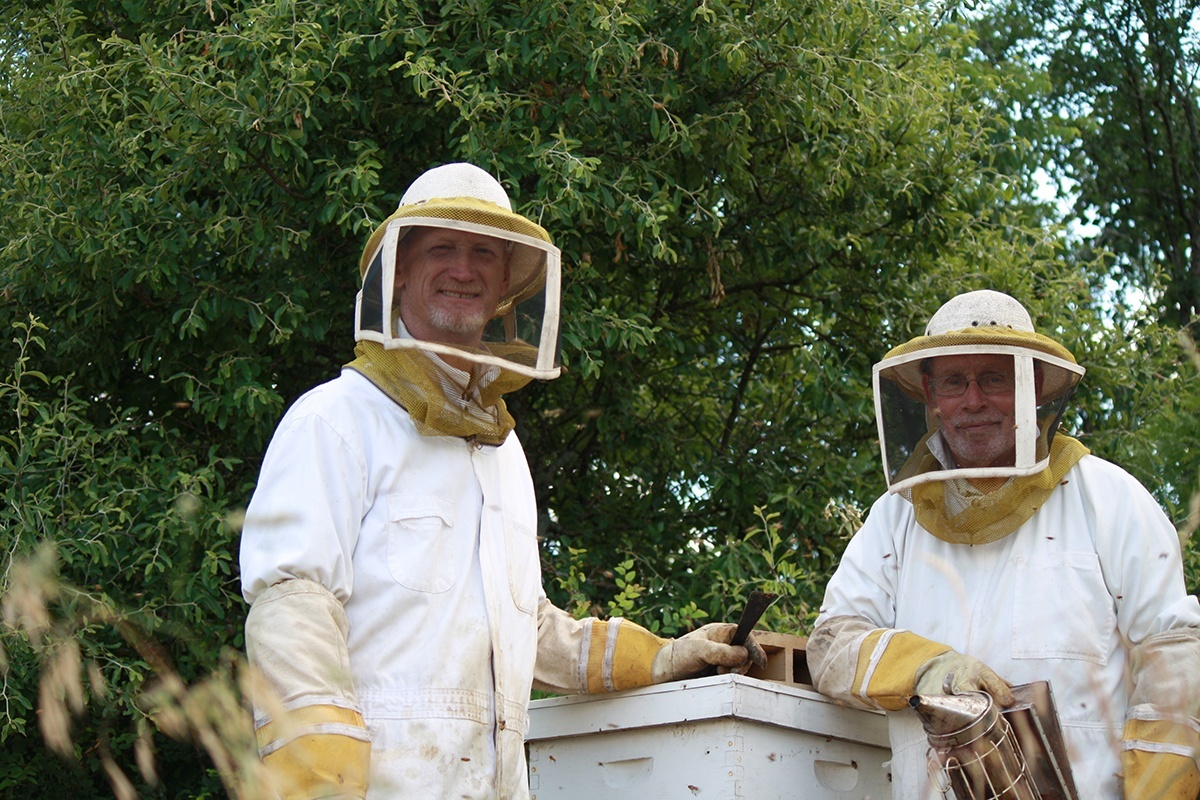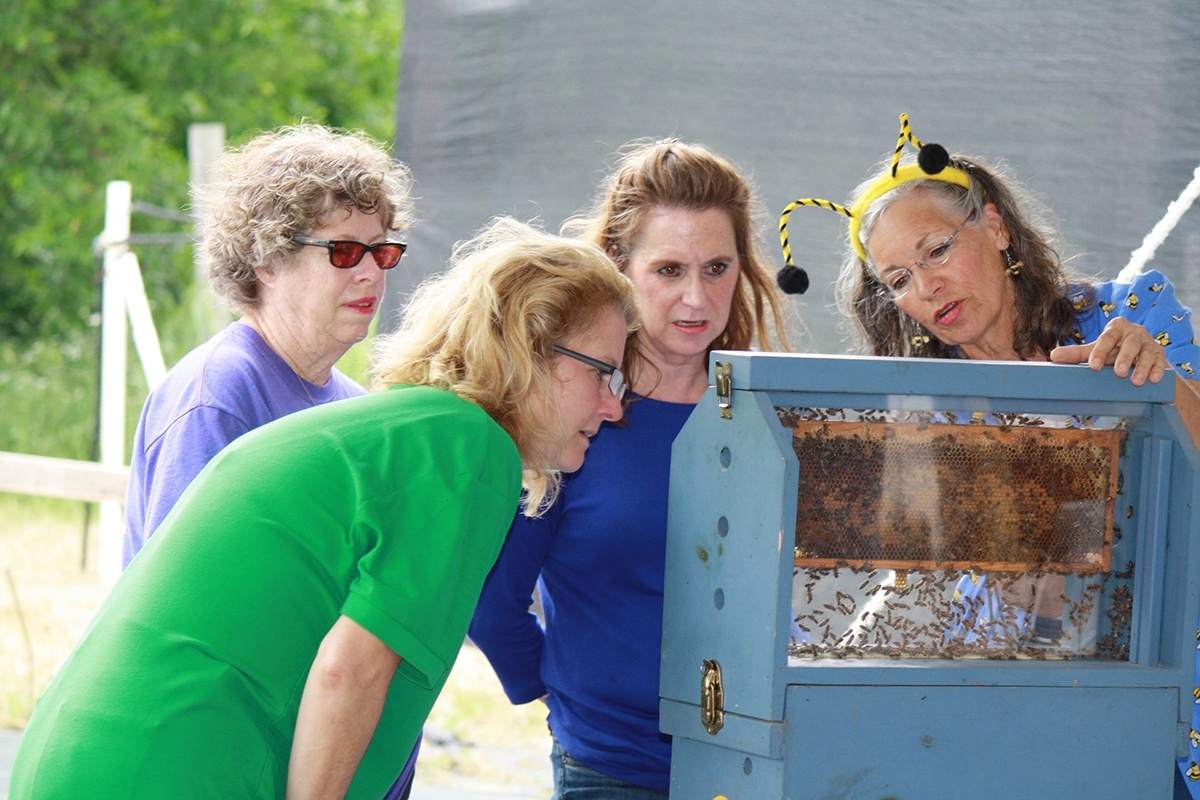Her chiropractor sounded a little desperate for a jar.
T’Lee Sollenberger, a beekeeping hobbyist, remembered feeling put on the spot during a recent visit. Her chiropractor wanted honey and asked Sollenberger while she stood in the waiting room. Sollenberger had none left.
“Are you sure there’s not just one jar,” her chiropractor asked.
But no. Not one.
Honey collection at Sollenberger’s farm usually starts in the vicious heat of July when she will don a protective beekeeping suit in oppressive 100-degree heat and collect frames laden with the sweet syrup. It’s a miserable task, she said. Thankless, even. And once collected, she must process it as quickly as possible (within three days), otherwise stowaway hive beetles may destroy it.
In her honey room off the garage, she described how one machine’s flailing chains uncap the honeycomb. Beside it, a centrifuge pulls honey from the hexagonal cells. The spinning turns the honey to a foam, so it must sit for a day or two before it’s poured off into bottles and jars.
It’s sticky. It’s messy. And if there’s one thing Sollenberger said she despises, it’s being sticky and messy.
“I absolutely hate it,” she said, laughing at the irony. “I am the kind of person who is constantly washing my hands.”
She loves it, too, she said. It’s a calling and a way of life. Beekeeping itself is an ancient human pastime. A cave painting in Spain depicts prehistoric honey-gathering from about 8,000 years ago. Ancient papyrus artifacts detail how Egyptians began keeping bees about 5,000 years ago.In 1621, European settlers brought the practice to the New World for sweetness and light, Sollenberger said. The insects provided honey for food and wax for candles to light homes and churches in particular.
While many aspects of beekeeping have remained the same for hundreds of years, today’s local beekeepers face new challenges and must craft new solutions. From Africanization, Colony Collapse Disorder, pesticide use, diseases and invasive foreign invaders such as hive beetles and varroa mites plaguing their hives to the whims of the weather, all can impact their crop. The practice is far from passive and demands constant attention.
Palace Intrigue and Hive Society
One queen reigns in a hive.
But that reign is in name only. A little secret: the female worker bees really do the ruling.
The queen’s job is to make bees. She lays about 1,500 to 2,000 eggs a day to keep up with natural attrition and to increase food stocks. Worker bees serve as her constant companions, feeding and grooming her and cleaning or building cells for her to lay new eggs. The size of the cell that a worker bee builds into the brood comb will determine if the queen will lay a fertilized egg for a female, an unfertilized egg to become a male, or an egg for a new queen.
Locally, queens live two to three years. If the queen’s pheromones begin to fail, workers will create queen cells in the brood comb. The old queen willingly lays eggs into these cells. The larvae are fed only royal jelly. This ensures transformation into fertile queens.
The old queen eventually is cast out from her palace. Up to 60 percent of a hive can leave with an old queen when this swarm strikes out to find a new home. Once a suitable homestead is found, the new hive’s workers also will build queen cups for her replacement. The old queen’s days are numbered.
That’s not the only reason why swarming occurs, though. Congestion in the hive can cause workers to raise too many queens and lack of available forage also can trigger swarms.
Male bees are called drones, and they’re freeloaders. They can’t feed themselves when young. They don’t gather nectar and pollen. Larger than female worker bees, their job is to fertilize virgin queen bees. Once they mate, they die. Queens mate with about 17 different drones, storing the sperm inside their bodies until ready to lay eggs.
When food becomes scarce in the fall, the remaining unmated drones are kicked outside into the cold to die.
That leaves the worker bees, who do all the work. Though they are female, they can’t reproduce. Depending on their age in the bee lifecycle, they clean cells for eggs, nurse baby bees, make royal jelly and wax to build honeycomb and seal up honey, feed drones, attend to the queen, make a brown “caulk” from tree sap called propolis, serve as undertakers, carry water and fan their wings to cool the hive, collect pollen and nectar and guard the door of the hive from intruders before finally dying of overwork in their four to six weeks of life during the busy season.
The Hobbyist
A PVC lattice-and-pipe honey stand guards the entrance of Sollenberger’s long driveway.
When she has honey to sell, her hand-painted A-frame signs pop up around the neighborhood, she said. Then she’s swarmed by humans looking for jars of raw honey or trying her products.
For seven years, she tried to become a business. However, the workload was immense, she said, and the expenses she faced as a small business owner overwhelmed the profits. So, she again became a hobbyist. These days, she said she’s in it for the passion and not the profit.
Sollenberger caught the bee bug in May of 1999, although she contemplated beekeeping for much longer. A neighbor supplied her a “starter kit” of some Langstroth boxes and a stray swarm.
“Most hobby beekeepers get started because they want to pollenate their gardens,” she said. “I think I just wanted to play with them. I have been playing with insects since I was a little girl. I used to pick them up all the time.”
In the back of her six-and-a-half acre farm, Sollenberger said she keeps a maximum of three hives here because she is surrounded by other beekeepers. She doesn’t want to make foraging for food difficult for the bees, so she’s spread the rest of her 25 hives throughout Johnson County.
Sollenberger said as much as she’s a hobbyist, she’s also an entrepreneur. Sometimes, she said, she will lie awake thinking of new ways that the wax, the honey and the propolis can be fashioned into what she called “value-added products.” She makes candles, jams, jellies and relishes. She also creates honey soaps, honeyaki marinade, beeswax lip balms and other skin care products. One product invention, called Nurse Bee, has become her hottest seller. Customers with eczema or psoriasis have shown miraculous results from its use, she said.
Sollenberger said she worries about the bees. Not just hers. All bees.
Neurotoxic pesticides, monocultural agriculture practices, invasion from varroa mites and hive beetles, habitat loss and bacterial and viral infections have played roles in what scientists call Colony Collapse Disorder. First documented in 2006, beehives suddenly turned up empty without a trace.
While scientists monitor the situation, media in many states, such as New York, Maryland and Colorado, have reported new interest in backyard beekeeping due to honeybee decline as well as interest in health claims about honey.
“Bees can overcome some of it, but there is a tipping point,” Sollenberger said. “I don’t know if we’re going to have bees here in the next 20 years. Two species of bumblebees went extinct this year. They’re gone now. I think though that the savior of the honey bee will be the backyard beekeeper. I’m hopeful.”
The Wholesalers
At first, silence dominated the field except for an intermittent croaking frog and an occasional cow.
Scott Jackson and Carlos Hambleton suited up in the metal barn on Jackson’s property. They wore an extra long-sleeve shirt followed by a loose-fitting, white beekeeping suit taped at the heel to their shoes. Next, a pith helmet and veil zipped onto the neckline. Another piece of duct tape closed the small zipper gap. Finally, elbow-length gloves.
About 40 yards away, a small hive with a brood box and two “supers” holding honeycomb awaited. It’s one of three on this property and 20 in total. On this May evening, the men checked the hive’s honey production and placed a hive beetle trap.
Before they walked to the hive, Hambleton dropped packing paper and tree bark into a bee smoker. Smoking the bees keeps them from aggressively protecting against the intrusion they were about to commit.
Jackson removed the top, and guard bees began looking for an invader. Hambleton puffed smoke between the frames, which convinced the bees that their home was on fire. Instinctively, they gorged on honey in case of an emergency relocation.
“As you can see, this is a really gentle hive,” Jackson said. Except for the guard bees, they were. Invaders into an Africanized hive would get swarmed by a mass exodus, he said. Most members of this domesticated hive clung to the comb and let the guards do their jobs.
In the 1950s, scientists introduced African honeybees in Brazil to increase honey production. In 1957, swarms escaped quarantine and spread across South America. Africanized hives were discovered in North America in 1985 and in South Texas in 1990. Now, they’re part of beekeeping reality in this area and other Southern states.
For all the talk and fear about Africanized honeybees, hybridization also has advantages, Jackson says.
“Hybrid bees are not pure-strength, aggressive bees,” he said. “They are more aggressive, but we have witnessed they are better producers of honey than the Italian bees. They’re also less picky. African bees take anything they can get, and they tend to put up a little more honey.”
The frames inside the honey supers were filling fast, and both men predicted a good harvest. They moved the honey supers off the top to inspect the brood box where the queen works. A metal grate called a queen excluder prevented the queen from venturing into the honey supers to lay eggs.
“The more I got into hives and learned about how bees store pollen and how there are guardian bees, nurse bees, and all types of bees, the more I believed in the fact that there has to be a divine creator,” Jackson said. “They fascinate me with all the stuff they can do. We learn something every time we go into the hive. It’s just amazing what they can do.”
Back in the barn, Jackson and Hambleton described how they met 25 years ago.
“I had a swarm of bees come in my backyard and called the city,” Hambleton said. “They called J.R. Cantrell, and he came over. They asked if I wanted to help, and I said ‘sure.’ So, we got the bees and put them in this hive. I had a garden, so we put them out there.”
Cantrell, a longtime area beekeeper who would become Hambleton’s mentor, had Jackson and Dale Brock in tow that day. Jackson and Brock ran cows together, and Brock would ask Jackson to assist with Brock’s bees after working cattle.
As Jackson and Hambleton’s interest and hives grew, the four men would meet regularly at a café in Alvarado to talk bees and other business. Jackson and Hambleton worked with Cantrell until about eight years ago.
“J.R. was probably about 91 or 92,” Jackson said. “He evidently saw that his body just wasn’t functioning like it needed to. He said, ‘Here. Just buy this from me. Give me this much money.’ He didn’t give me an option. So, I did. Then I said ‘Carlos, I can’t do this alone. Come on, we could do something bigger here.’”
The six to 10 original outlets that bought their honey have grown to 50 or 60, they said. The pair blends the honey made from the 20 hives in Johnson County with some from San Antonio beekeepers and sell under the name Texas Raw Honey.
“As a business, there are apparent parallels with United Cooperative Services’ approach and that of our honey operation,” Jackson said. “I think what we’ve heard for years is still true today. You have a good product and or service, you put the customer first and you can hardly lose. I think it’s the foundation of good business.”



